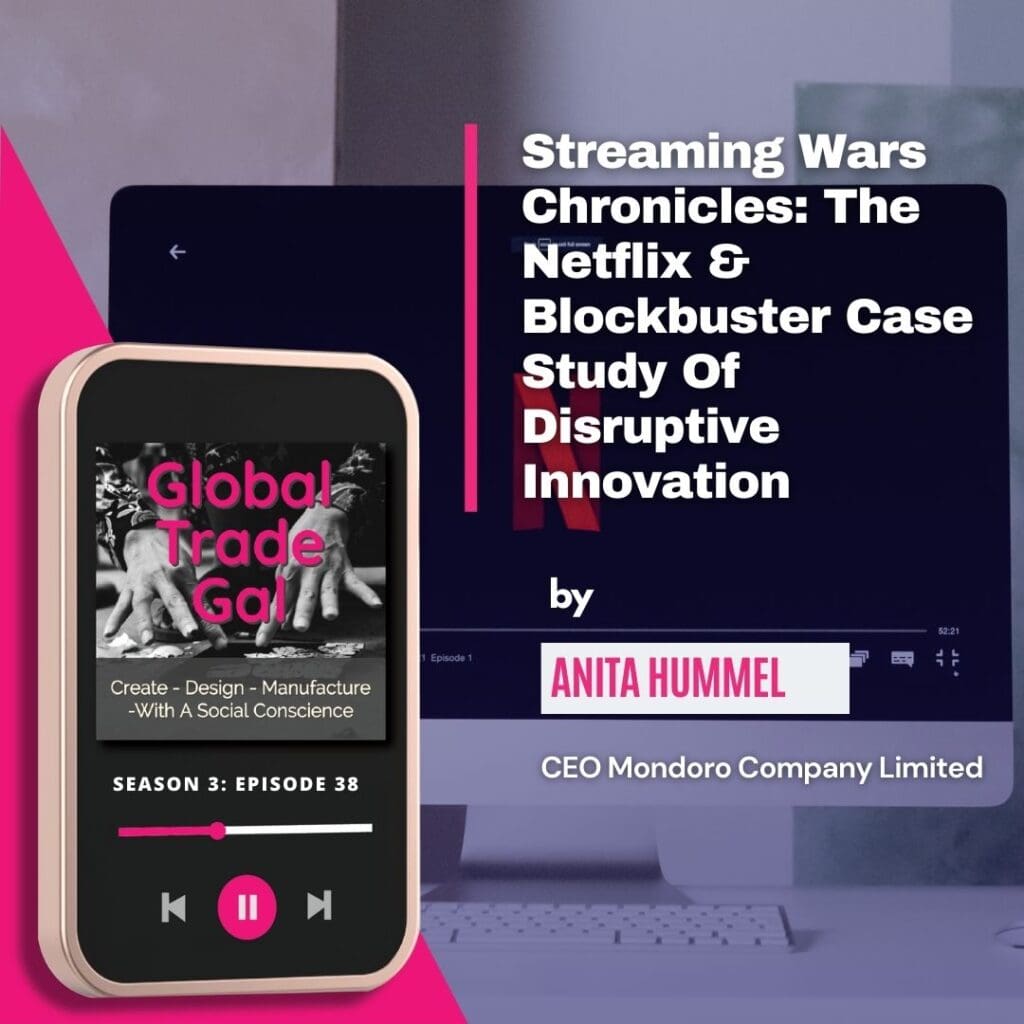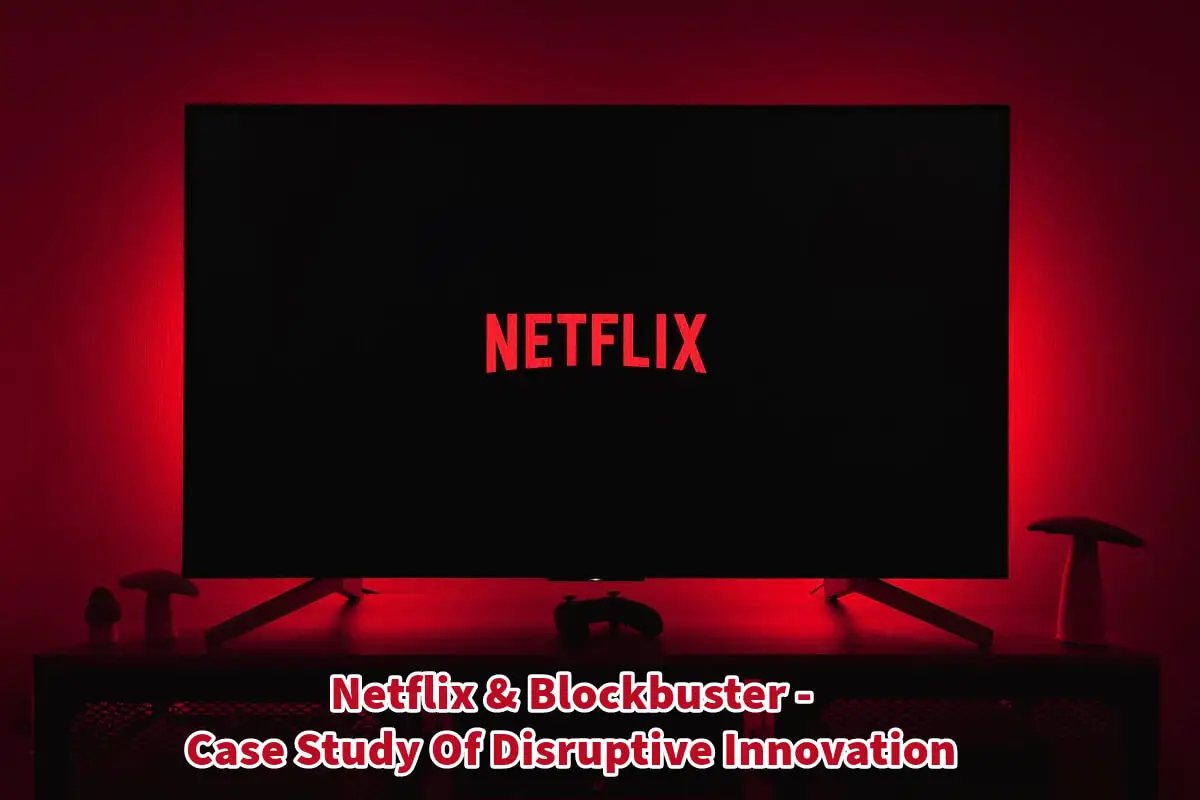It’s rare for a week without me tuning into Netflix to watch something or at least browse its offerings to find my next binge-worthy series. I know I’m not alone in this habit; countless others probably engage in the same routine.
That’s why examining the Netflix and Blockbuster case study is so enlightening. It offers a riveting look at how disruptive innovation can permanently alter the digital landscape. One company survived and flourished, while the other faded into business irrelevance. As we delve into key learnings from this case study, we also discuss what contemporary companies can do to avoid meeting the same fate as Blockbuster.
Table of Contents
- Netflix & Blockbuster: A Case Study In Disruptive Innovation
- Brief History Of Netflix
- Disruptive Strategies Used By Netflix
- Blockbuster’s Missed Opportunities
- The Importance Of Transformation In Business
- Lessons From The Netflix & Blockbuster Case Study On Disruptive Innovation
- Related Questions
Netflix & Blockbuster: A Case Study In Disruptive Innovation
One of the most compelling case studies in disruptive innovation is the saga of Netflix and Blockbuster. This story provides valuable insights into how Netflix managed to upend the industry, positioning itself as a dominant force in today’s digital landscape.
Continue reading as we delve deeper into the disruptive journey of Netflix and Blockbuster.
Understanding Disruptive Innovation
Digital disruption has been a game-changer in entrepreneurial strategies since the late 20th Century. Contrary to popular belief, disruptive innovation is not the same as mere creativity.
While creating a fuel-efficient engine might draw a new consumer base, the minor variations from standard engines do not categorize it as disruptive. True disruption focuses on targeting sectors that established companies overlook or revolutionizing an existing system.
This case study delves into how Netflix applied disruptive innovation to dethrone Blockbuster in the home entertainment industry.
Brief History Of Netflix
Understanding its history is crucial to grasp the scale of Netflix’s disruption fully. Netflix was founded in 1998 by Reed Hastings and Marc Randolph in Scott’s Valley, California, with an initial investment of $2.5 million from Hastings.
Opting to distribute DVDs rather than bulky and fragile VHS tapes, Netflix started with 30 employees and 925 available titles. Over time, the company introduced a monthly subscription model, eliminating the single rental system. It positioned itself as a consumer-friendly alternative to Blockbuster’s model, often including late fees and hidden charges.

Netflix’s Early Challenges
Netflix wasn’t always the giant we know today. In 2000, the company even offered to sell itself to Blockbuster for $50 million—an offer that Blockbuster refused.
Following the dot-com bubble burst and the 9/11 attacks, Netflix was forced to lay off two-thirds of its staff. However, the proliferation of affordable DVD players and an IPO in 2002 helped the company regain its footing.
Disruptive Strategies Used By Netflix
Netflix employed various disruptive approaches to outmaneuver Blockbuster in the market. Continue reading to uncover two of these critical, innovative strategies.
Low-End Footholds
Netflix initially targeted lower-end markets that Blockbuster ignored. It presented itself as a hassle-free alternative to Blockbuster by eliminating late fees. This allowed Netflix to grow its customer base steadily.
The company focused on improving service speed and video quality, gradually becoming a preferred choice over Blockbuster for many consumers.
New Market Footholds
Netflix further disrupted the industry by introducing DVDs and streaming services. Their easy-to-use online interface and innovative recommendation algorithm provided an experience Blockbuster couldn’t match.
They also invested in creating original content, widening their market appeal, and keeping audiences engaged.
Blockbuster’s Missed Opportunities
Blockbuster’s business model worked well for a time, but their complacency in innovation left them vulnerable to disruption. They continued to rely on an aging model that included late fees and did not adapt quickly enough to new technologies.
When they finally attempted to catch up, it was too late, and they were already in decline.

The Importance Of Transformation In Business
While disruptive innovation is crucial for capturing market share, continual transformation is essential. Netflix’s willingness to adapt allowed it to evolve from a DVD rental service to a streaming giant.
Conversely, Blockbuster’s resistance to change led to its downfall. The case of Netflix vs. Blockbuster is a compelling example of how disruptive innovation can reshape industries and why companies must adapt to survive.
Lessons From The Netflix & Blockbuster Case Study On Disruptive Innovation
The evolution of Netflix and the decline of Blockbuster serve as an epic tale of disruptive innovation in the business landscape. This case study provides insights into strategic decision-making and offers lessons on how to deal with market transformation.
Here are ten key lessons companies can learn from this saga.
1. Adapt Or Perish
The inability of Blockbuster to adapt to emerging technologies and new consumer preferences, especially around the convenience of movie rentals, was a critical downfall. Companies must be agile and willing to adapt their business models to remain relevant.
2. Recognize Low-End Footholds
Netflix capitalized on the aspects of the market that Blockbuster ignored, primarily around consumer annoyance with late fees. Companies should be cautious not to ignore market segments that might seem less profitable or secondary, as they may become entry points for disruptive competitors.
3. Embrace Technology Early
Netflix took a risk by betting on DVDs and online streaming. Companies should look towards emerging technologies as opportunities for future growth and be willing to invest early, even if the technology hasn’t yet reached mass adoption.
4. Customer-Centric Approach
Netflix’s recommendation algorithm, easy-to-use interface, and concern for customer experience made them a consumer favorite. Companies should place the customer at the center of their business model and continually strive to improve the user experience.
5. Stay Ahead Through Innovation
Netflix invested in original content to differentiate itself further from Blockbuster and new competitors. Companies must continuously innovate and expand their offerings to keep customers engaged and deter potential entrants.
6. Use Data Intelligently
Netflix has been a pioneer in utilizing big data to understand customer behavior and preferences. Companies should leverage data analytics to make more informed decisions and to tailor their services/products to individual customer needs.
7. Anticipate Future Trends
While Blockbuster remained committed to physical stores, Netflix anticipated the shift toward digital consumption. Forecasting and acting upon trends can differentiate between leading the market or becoming obsolete.
8. Understand Market Signals
Blockbuster missed the signals when Netflix offered to sell itself for $50 million, and consumers began to show dissatisfaction with late fees. Recognizing and acting upon market signals, even subtle ones, can impact a company’s trajectory.
9. Transformation Is Continuous
Even after establishing itself as a leader in streaming, Netflix continues to evolve and adapt. Understanding that transformation is an ongoing process rather than a one-time event is crucial for long-term success.
10. Learn From Failures
Both Netflix and Blockbuster had their share of mistakes. However, Netflix has shown an ability to learn from its failures, pivot, and recover. Companies should not only celebrate successes but also see failures as learning opportunities.
The tale of Netflix and Blockbuster is a masterclass in understanding disruptive innovation and market transformation mechanics. By recognizing early signs of disruption, staying adaptable, and being committed to continuous improvement and innovation, companies can remain competitive and relevant in their respective markets.
Listen To Our Podcast About Streaming Wars Chronicles: The Netflix & Blockbuster Case Study Of Disruptive Innovation Below or By clicking here.

Find out more about how Mondoro can help you create, develop, and manufacture excellent home decor and home furniture products – don’t hesitate to contact me, Anita. Check out my email by clicking here, or become a part of our community and join our newsletter by clicking here.
Mondoro gives out a FREE Lookbook to anyone interested. You can receive a copy of our latest Lookbook by clicking here.
Listen to our Podcast called Global Trade Gal. You can find it on all major podcast platforms. Try out to listen to one of our podcasts by clicking here.
Subscribe to our Mondoro Company Limited YouTube Channel with great videos and information by clicking here.
Related Questions
5 Questions To Ask When Considering A Solid Wood Furniture Manufacturer
One of the things we look at when we go into a new solid wood furniture manufacturer is in-house kiln wood drying. We also want to know if they understand how to join the wood properly and have the equipment. Also, if the manufacturer is in a hot and tropical climate if they have a dry room to help control the wood moisture levels. We like to work with factories that cut and shape all the wood and have in-house finishing facilities.
You can discover more by reading our blog 5 Questions To Ask When Considering A Solid Wood Furniture Manufacturer; read more by clicking here.
What is Solid Wood vs. Engineered Wood?
Solid wood is cut down from the tree, cut into wood boards, and then used for manufacturing. On the other hand, engineered wood is considered manmade as it is usually manufactured with wood chips, wood shavings, and an adhesive. Today the manufacturing of engineered wood is extremely technical.
You can discover more by reading our blog All About Teak Wood And Outdod? by clicking here.
Hardwood Solids Furniture, What Does The Term Mean?
Hardwood solids can include non-solid woods such as engineered woods. Hardwood solids are used in furniture and other industries to classify what wood is used in a product. The terms usually do not classify what type of wood is used.
You can discover more by reading our blog Hardwood Solids Furniture, What Does The Term Mean? by clicking here.


